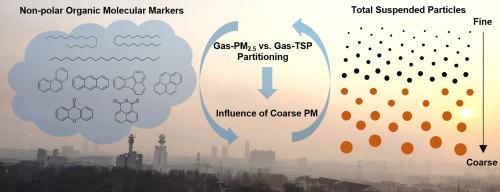Comparisons of gas-PM2.5 and gas-TSP partitioning of non-polar organic molecular makers in northern Nanjing, China
IF 4.4
2区 地球科学
Q1 METEOROLOGY & ATMOSPHERIC SCIENCES
引用次数: 0
Abstract
The gas-particle (G-P) partitioning of semi-volatile organic compounds has been commonly investigated by simultaneously measuring their concentrations in the gas and particle phases, but the effects of coarse particles were not well known. In this study, collocated gas-PM2.5 and gas-TSP samples were collected in the suburbs of Nanjing, a typical megacity in the Yangtze River Delta in China, and analyzed for non-polar organic molecular markers (NP-OMMs), including n-alkanes, polycyclic aromatic hydrocarbons (PAHs), oxygenated PAHs (oxy-PAHs), and steranes and hopanes. Except for low-volatility n-alkanes (vapor pressure < 10−10 atm), all other groups of NP-OMMs in paired PM2.5 and TSP samples had comparable median concentrations, and the concentration time series of PAHs, oxy-PAHs, and steranes and hopanes were strongly correlated (r > 0.80, p < 0.01). Based on the collocated measurements of gaseous samples, the relative uncertainties for the concentrations of grouped n-alkanes and oxy-PAHs (17.3 %–27.7 %) are greater than for the PAHs (12.4 %–21.3 %). The mean particulate fractions of the grouped NP-OMMs were almost identical between gas-PM2.5 and gas-TSP samples, indicating a weak influence of coarse particles on the distribution of NP-OMMs in the gas and particle phases in Nanjing. Whenever the gas-PM2.5 or gas-TSP data were used to validate the prediction of G-P partitioning coefficients, the partitioning of gaseous n-alkanes and PAHs into the particle phase was majorly driven by absorption and adsorption mechanisms, respectively. When coarse particles were considered for the prediction of the G-P partitioning of PAHs, less liquid-like sorption had to be assumed.

南京北部非极性有机分子制造者气体- pm2.5和气体- tsp分配比较
半挥发性有机化合物的气相-颗粒(G-P)分配通常是通过同时测量它们在气相和颗粒相中的浓度来研究的,但粗颗粒的影响尚不清楚。本研究以南京郊区为研究对象,采集了南京郊区空气中pm2.5和tsp的样本,分析了正构烷烃、多环芳烃(PAHs)、含氧多环芳烃(oxy-PAHs)、甾烷和藿烷等非极性有机分子标记物。除低挥发性正构烷烃(蒸气压<;10−10 atm), PM2.5和TSP成对样品中所有其他组NP-OMMs的中位数浓度相当,多环芳烃、氧基多环芳烃、甾烷和藿烷的浓度时间序列呈强相关(r >;0.80, p <;0.01)。基于对气体样品的同步测量,分组正构烷烃和氧-多环芳烃浓度的相对不确定度(17.3% ~ 27.7%)大于多环芳烃浓度(12.4% ~ 21.3%)。分组NP-OMMs的平均颗粒组分在气体- pm2.5和气体- tsp样品中几乎相同,表明粗颗粒对南京气体和颗粒相NP-OMMs分布的影响较小。当使用pm2.5或tsp数据验证G-P分配系数预测时,气态正构烷烃和多环芳烃分别主要受吸附和吸收机制驱动进入颗粒相。当考虑粗颗粒来预测多环芳烃的G-P分配时,必须假设较少的液体状吸附。
本文章由计算机程序翻译,如有差异,请以英文原文为准。
求助全文
约1分钟内获得全文
求助全文
来源期刊

Atmospheric Research
地学-气象与大气科学
CiteScore
9.40
自引率
10.90%
发文量
460
审稿时长
47 days
期刊介绍:
The journal publishes scientific papers (research papers, review articles, letters and notes) dealing with the part of the atmosphere where meteorological events occur. Attention is given to all processes extending from the earth surface to the tropopause, but special emphasis continues to be devoted to the physics of clouds, mesoscale meteorology and air pollution, i.e. atmospheric aerosols; microphysical processes; cloud dynamics and thermodynamics; numerical simulation, climatology, climate change and weather modification.
 求助内容:
求助内容: 应助结果提醒方式:
应助结果提醒方式:


